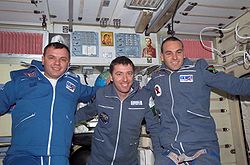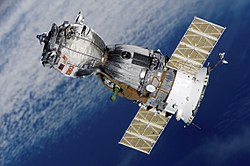This article needs additional citations for verification .(May 2008) |
 TM-34 docked to the ISS | |
| Mission type | ISS crew transport |
|---|---|
| Operator | Russian Space Agency |
| COSPAR ID | 2002-020A |
| SATCAT no. | 27416 |
| Mission duration | 198 days, 17 hours, 37 minutes, 45 seconds |
| Orbits completed | ~3,235 |
| Spacecraft properties | |
| Spacecraft | Soyuz-TM |
| Spacecraft type | Soyuz-TM |
| Manufacturer | Energia |
| Crew | |
| Crew size | 3 |
| Launching | Yuri Gidzenko Roberto Vittori Mark Shuttleworth |
| Landing | Sergei Zalyotin Frank De Winne Yury Lonchakov |
| Callsign | Uran |
| Start of mission | |
| Launch date | April 25, 2002, 06:26:35 UTC |
| Rocket | Soyuz-U |
| Launch site | Baikonur, Site 1/5 |
| Contractor | Progress |
| End of mission | |
| Landing date | November 10, 2002, 00:04:20 UTC |
| Landing site | 80 kilometres (50 mi) NE of Arkalyk |
| Orbital parameters | |
| Reference system | Geocentric |
| Regime | Low Earth |
| Perigee altitude | 193 kilometres (120 mi) |
| Apogee altitude | 247 kilometres (153 mi) |
| Inclination | 51.6 degrees |
| Period | 88.6 minutes |
| Docking with ISS | |
| Docking port | Zarya nadir |
| Docking date | 27 April 2002 07:55 UTC |
| Undocking date | 9 November 2002 20:44 UTC |
| Time docked | 196d 12h 49m |
  Soyuz programme (Crewed missions) | |
Soyuz TM-34 was the fourth Soyuz mission to the International Space Station (ISS). [1] Soyuz TM-34 was launched by a Soyuz-U launch vehicle.

